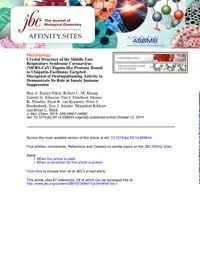
2014 Crystal Structure of the Middle East Respiratory Syndrome Coronavirus (MERS-CoV) Papain-like Protease Bound to Ubiq PDF
Preview 2014 Crystal Structure of the Middle East Respiratory Syndrome Coronavirus (MERS-CoV) Papain-like Protease Bound to Ubiq
and Brian L. Mark Kikkert Bredenbeek, Eric J. Snijder, Marjolein K. Ninaber, Puck B. van Kasteren, Peter J. Garrett G. Johnson, Tim J. Dalebout, Dennis Ben A. Bailey-Elkin, Robert C. M. Knaap, Suppression Demonstrate Its Role in Innate Immune Disruption of Deubiquitinating Activity to to Ubiquitin Facilitates Targeted (MERS-CoV) Papain-like Protease Bound Respiratory Syndrome Coronavirus Crystal Structure of the Middle East Microbiology: doi: 10.1074/jbc.M114.609644 originally published online October 15, 2014 2014, 289:34667-34682. J. Biol. Chem. 10.1074/jbc.M114.609644 Access the most updated version of this article at doi: . JBC Affinity Sites Find articles, minireviews, Reflections and Classics on similar topics on the Alerts: When a correction for this article is posted • When this article is cited • to choose from all of JBC's e-mail alerts Click here http://www.jbc.org/content/289/50/34667.full.html#ref-list-1 This article cites 67 references, 29 of which can be accessed free at at Univ of Reading on December 24, 2014 http://www.jbc.org/ Downloaded from at Univ of Reading on December 24, 2014 http://www.jbc.org/ Downloaded from Crystal Structure of the Middle East Respiratory Syndrome Coronavirus (MERS-CoV) Papain-like Protease Bound to Ubiquitin Facilitates Targeted Disruption of Deubiquitinating Activity to Demonstrate Its Role in Innate Immune Suppression* Received for publication,September 3, 2014, and in revised form, September 30, 2014 Published, JBC Papers in Press,October 15, 2014, DOI 10.1074/jbc.M114.609644 Ben A. Bailey-Elkin‡1,2, Robert C. M. Knaap§2, Garrett G. Johnson‡, Tim J. Dalebout§, Dennis K. Ninaber§, Puck B. van Kasteren§, Peter J. Bredenbeek§, Eric J. Snijder§, Marjolein Kikkert§3,4, and Brian L. Mark‡3,5 From the ‡Department of Microbiology, University of Manitoba, Winnipeg, Manitoba R3T 2N2, Canada and the §Molecular Virology Laboratory, Department of Medical Microbiology, Leiden University Medical Center, 2333 ZA Leiden, The Netherlands Background: MERS-CoV papain-like protease (PLpro) processes viral polyproteins and has deubiquitinating activity. Results: A crystal structure of MERS-CoV PLpro bound to ubiquitin guided mutagenesis to disrupt PLpro deubiquitinating activity without affecting polyprotein cleavage. Conclusion: The deubiquitinating activity of MERS-CoV PLpro suppresses the induction of interferon-� expression. Significance: Our strategy to selectively disable PLpro deubiquitinating activity enables the study of its specific functions in infection. Middle East respiratory syndrome coronavirus (MERS-CoV) is a newly emerging human pathogen that was first isolated in 2012. MERS-CoV replication depends in part on a virus-en- coded papain-like protease (PLpro) that cleaves the viral repli- case polyproteins at three sites releasing non-structural protein 1 (nsp1), nsp2, and nsp3. In addition to this replicative function, MERS-CoV PLpro was recently shown to be a deubiquitinating enzyme (DUB) and to possess deISGylating activity, as previ- ously reported for other coronaviral PLpro domains, including that of severe acute respiratory syndrome coronavirus. These activities have been suggested to suppress host antiviral responses during infection. To understand the molecular basis for ubiquitin (Ub) recognition and deconjugation by MERS- CoV PLpro, we determined its crystal structure in complex with Ub. Guided by this structure, mutations were introduced into PLpro to specifically disrupt Ub binding without affecting viral polyprotein cleavage, as determined using an in trans nsp324 cleavage assay. Having developed a strategy to selectively disable PLpro DUB activity, we were able to specifically examine the effects of this activity on the innate immune response. Whereas the wild-type PLpro domain was found to suppress IFN-� pro- moter activation, PLpro variants specifically lacking DUB activ- ity were no longer able to do so. These findings directly impli- cate the DUB function of PLpro, and not its proteolytic activity per se, in the inhibition of IFN-� promoter activity. The ability to decouple the DUB activity of PLpro from its role in viral poly- protein processing now provides an approach to further dissect the role(s) of PLpro as a viral DUB during MERS-CoV infection. The Middle East respiratory syndrome coronavirus (MERS- CoV)6 was first isolated in June 2012 from a patient in Saudi Arabia who had died from progressive respiratory and renal failure (1). Since then, over 800 cases have been reported, with a case fatality rate surpassing 30% (2). The progression and sever- ity of the symptoms observed in MERS patients resemble the severe acute respiratory syndrome (SARS) observed in patients infected with SARS-CoV, which caused a global pandemic in 2003, resulting in over 8000 cases, with a case fatality rate of �10% (3). Whereas the SARS-CoV outbreak was contained within months, MERS cases continue to occur 2 years after the emergence of MERS-CoV in the human population. Currently, dromedary camels are suspected to be one of the direct reser- voirs for the zoonotic transmission of MERS-CoV, although the exact chain of transmission remains to be explored in more detail (4, 5). MERS-CoV and SARS-CoV are enveloped, positive-sense single-stranded RNA (�RNA) viruses that belong to the Beta- coronavirus genus in the family Coronaviridae of the Nidovi- rales order (6). The CoV non-structural proteins (nsps), which * This work was supported in part by Natural Sciences and Engineering Research Council of Canada Grant 311775-2010 (to B. L. M.), the Division of Chemical Sciences of the Netherlands Organization for Scientific Research (NWO-CW) through ECHO grant 700.59.008 (to M. K. and E. J. S.), and the European Union Seventh Framework Programme (FP7/2007–2013) under SILVER grant agreement 260644. The atomic coordinates and structure factors (codes 4REZ, 4RF1, and 4RF0) have been deposited in the Protein Data Bank (http://wwpdb.org/). 1 Recipient of a Research Manitoba Studentship. 2 Both authors contributed equally to this work. 3 Both authors contributed equally to this work. 4 To whom correspondence may be addressed. Tel.: 31-71-526-1442; Fax: 31-71-526-6981; E-mail:
